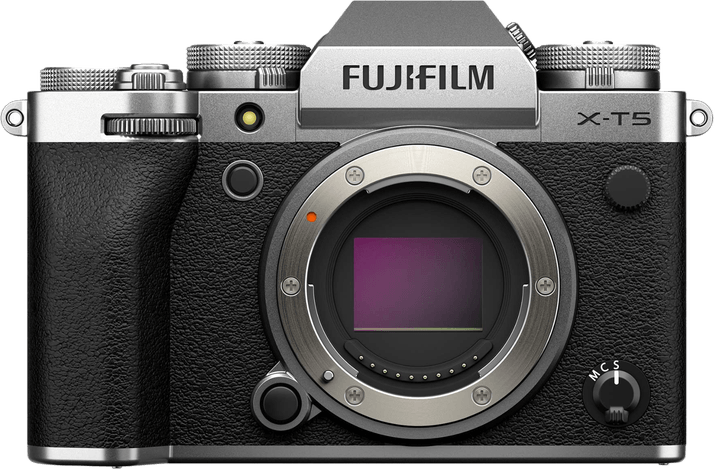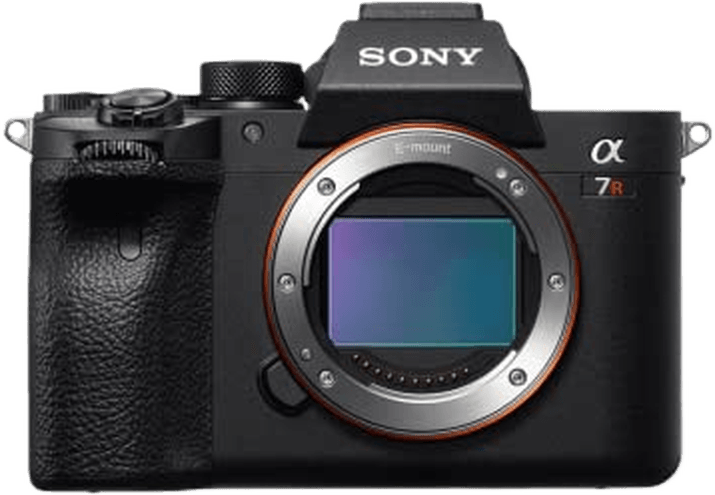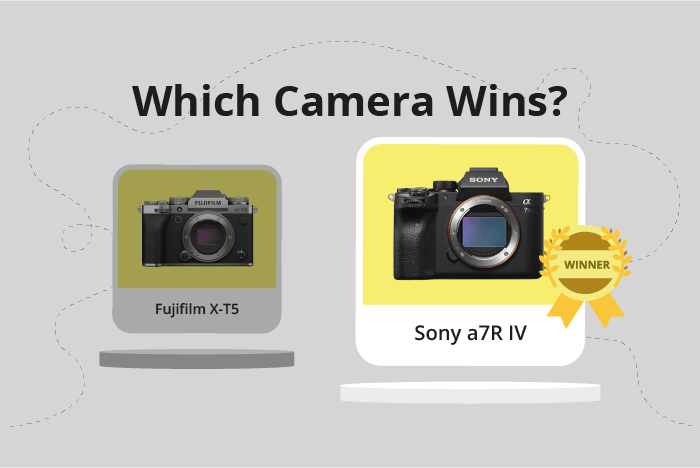Fujifilm X-T5 vs Sony a7R IV Comparison
Fujifilm X-T5

Sony a7R IV

The Sony a7R IV outperforms the Fujifilm X-T5 with a score of 84/100 compared to 81/100. Both cameras are mirrorless and have similar sizes, with the X-T5 measuring 130 x 91 x 64mm and the a7R IV at 129 x 96 x 78mm. The Fujifilm X-T5 is lighter at 557g, while the Sony a7R IV weighs 665g.
The Sony a7R IV’s higher score highlights its better performance. It was released in 2019 with a launch price of $3500, indicating its premium features. On the other hand, the Fujifilm X-T5, released in 2022, has a more affordable price tag of $1699, making it a good option for budget-conscious photographers.
While the Sony a7R IV offers superior performance, the Fujifilm X-T5’s lighter weight and lower price make it an attractive alternative. Each camera has its merits, and the best choice depends on individual preferences and requirements.
Fujifilm X-T5 vs Sony a7R IV Overview and Optics
The Sony a7R IV outperforms the Fujifilm X-T5 in optics with a score of 85/100, while the Fujifilm X-T5 scores 81/100. Both cameras share common features such as CMOS sensor types, processors, and image stabilization. However, the Sony a7R IV excels in certain aspects, making it the winner in this comparison.
The Sony a7R IV has a higher megapixel count of 61.2, compared to the Fujifilm X-T5’s 40 megapixels. This difference allows the Sony a7R IV to capture more detail and produce higher resolution images. Additionally, the Sony a7R IV boasts a full-frame sensor size and a DXOMARK sensor score of 99, providing better image quality and low-light performance than the Fujifilm X-T5, which has an APS-C sensor size and no DXOMARK score.
On the other hand, the Fujifilm X-T5 has a faster shooting speed of 15 frames per second, compared to the Sony a7R IV’s 10 frames per second. This advantage allows the Fujifilm X-T5 to perform better when capturing fast-moving subjects or action scenes.
Despite the Fujifilm X-T5’s faster shooting speed, the Sony a7R IV’s superior image quality and sensor performance make it the better choice in terms of optics. The full-frame sensor, higher megapixel count, and DXOMARK score of 99 contribute to the Sony a7R IV’s overall better performance in this category. While the Fujifilm X-T5 is a strong contender, its APS-C sensor size and lack of DXOMARK score ultimately hold it back in comparison to the Sony a7R IV.
Fujifilm X-T5 vs Sony a7R IV Video Performance
The Fujifilm X-T5 outperforms the Sony a7R IV in video capabilities, with a score of 87/100 compared to the Sony’s 70/100. Both cameras share some common features, such as having built-in time-lapse functionality. However, the Fujifilm X-T5 surpasses the Sony a7R IV in several aspects, making it the superior choice for video recording.
The Fujifilm X-T5 boasts a maximum video resolution of 6K (6240×4160), while the Sony a7R IV only offers 4K (3840×2160). This difference in resolution results in more detailed and crisper video footage for the Fujifilm X-T5. Additionally, the Fujifilm X-T5 can record videos at a higher frame rate of 60fps, versus the Sony a7R IV’s limitation to 30fps. This higher frame rate allows for smoother motion capture and more options for slow-motion playback.
Despite the lower video score, the Sony a7R IV does not have any significant advantages over the Fujifilm X-T5 in terms of video capabilities. Both cameras have built-in time-lapse functionality, but the Fujifilm X-T5’s higher resolution and frame rate make it the superior choice for time-lapse videos as well.
By considering the video capabilities of both cameras, it is clear that the Fujifilm X-T5 is the better option for those prioritizing video recording. The higher resolution and frame rate result in more detailed and smoother video footage, making the Fujifilm X-T5 a more versatile and powerful camera for videographers. The Sony a7R IV, while still a strong camera, falls short in comparison to the Fujifilm X-T5 in terms of video performance.
Fujifilm X-T5 vs Sony a7R IV Features and Benefits
The Fujifilm X-T5 emerges as the winner in the features comparison with a score of 85/100, slightly outperforming the Sony a7R IV, which scored 83/100. Both cameras share several specifications, which include a 3-inch screen size, touchscreen capability, flip screen, absence of GPS, and the presence of WIFI and Bluetooth connectivity.
The Fujifilm X-T5 has a superior screen resolution of 1,840,000 dots, compared to the Sony a7R IV’s 1,440,000 dots. This higher resolution provides more precise and clearer image previews and better menu navigation. Consequently, the X-T5 offers a more enjoyable and efficient user experience.
On the other hand, the Sony a7R IV does not surpass the Fujifilm X-T5 in any specific feature. However, it is important to note that the difference in their feature scores is minimal, which indicates that the a7R IV is still a solid camera option in terms of features.
Taking into account the advantages and disadvantages of each camera’s features, the Fujifilm X-T5 is the better choice for those who prioritize a higher screen resolution for a more comfortable and accurate viewing experience. Meanwhile, the Sony a7R IV is a suitable alternative for users who value the other shared specifications and can compromise on a slightly lower screen resolution.
Fujifilm X-T5 vs Sony a7R IV Storage and Battery
The Sony a7R IV outperforms the Fujifilm X-T5 in storage and battery with a score of 79/100, compared to the X-T5’s 76/100. Both cameras have two memory card slots and offer USB charging. However, the a7R IV accepts SD/SDHC/SDXC (UHS-II compatible) memory cards, providing faster read and write speeds than the X-T5’s UHS-I compatible cards. Additionally, the Sony a7R IV boasts a longer battery life, providing 670 shots per charge with its NP-FZ100 battery, while the Fujifilm X-T5 offers 580 shots using the NP-W235 battery.
Although the Fujifilm X-T5 falls short in storage and battery performance, it still provides adequate capacity and battery life for most photography needs. Both cameras deliver reliable performance, but the Sony a7R IV’s superior storage compatibility and extended battery life give it an edge in this category.
Alternatives to the Fujifilm X-T5 and Sony a7R IV
Are you still undecided about which camera is right for you? Have a look at these popular comparisons that feature the Fujifilm X-T5 or the Sony a7R IV:

